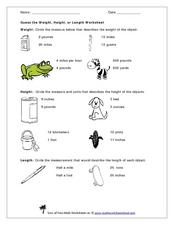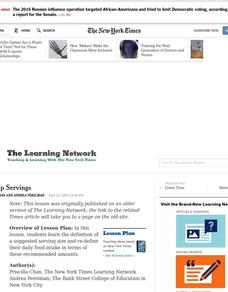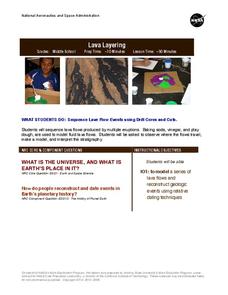Curated OER
Nature Art
In this nature art lesson, students take a nature walk and collect items with different sizes, textures and colors. Students use the items they collect to make a collage.
Curated OER
Guess the Weight, Height, or Length Worksheet
Kids can estimate weight, length, and height. Here, they circle the measurement that best describes the length, height, or weight of 10 different objects.
Curated OER
One Size Fits All?
Students describe the differences between an estimate and a guess. They create reasonable estimates based on comparison and activities. Students explain how estimation is helpful in showing the relative size on a scale. They also...
Curated OER
Sizing Up Servings
Students learn the definition of a suggested serving size and re-define their daily food intake in terms of these recommended amounts.
Curated OER
Sizing Up The Solar System
Students investigate and design various models of size and distance related to the solar system. They work together to build a solar system model. The models should focus on distance and scale. They don't include moons or satellites in...
BioEd Online
Serving Sizes
When it comes to eating a balanced diet, portion control is paramount, but what is the difference between the serving size on the nutrition facts label and a portion as determined by the USDA? In a comprehensive look at portion control,...
Baylor College
Comparing Sizes of Microorganisms
Kids compare what printed text looks like with the naked eye and under magnification. They discuss the extremely small scale that must be used to measure the size. They learn about the micrometer unit, then draw scale models of a variety...
T. Smith Publishing
The Same Size at the Beach
Rows of Nautilus shells, beach balls, sand pails, and sea gulls array this handout. Kindergartners compare the relative sizes in each row and simply color any that are the same size. This page would make terrific take-home practice for...
Curated OER
The Sun, Moon, and Our Solar System: Teacher/Student Notes
Introduce basic Earth and space science to your budding astronauts. This handout works in two ways, the first part provides information about the sun, moon, eclipses, and Earth to be read to or by the class. The second part is composed...
Physics Classroom
The L.O.S.T. Art of Image Description - Converging Lenses
Magnifying glasses and cameras often use converging lenses, but how do they alter an image? Pupils discover a lens, axis, and object arrow before identifying four characteristics of the resulting image. They label the location,...
Curated OER
What are Stars?
Students research the solar system and it's characteristics. In this solar system lesson, students are broken into 4 groups, each assigned a specific part of the solar system. Students use the Internet to research their part of the...
National Nanotechnology Infrastructure Network
Big vs. Little - Macro to Micro Lesson 1
Small and large are relative terms; what's the best way to quantify them? Young scientists take on that challenge as they complete an interactive activity to explore size. They build structures during their exploration and begin using...
Delegation of the European Union to the United States
The Geography of Europe
What is the European Union? Where is it? Why is it? To begin a study of the EU, class members examine the physical geography of Europe and the size and population density of 28-member countries in comparison to non-member countries like...
CK-12 Foundation
Black Hole
What happens to radio waves, time, and light in and near a black hole? Young scientists explore what is known about observing frequency and time at various distances from a black hole. They control the size of the black hole and the...
California Academy of Science
Moons in Comparison
Just how big is Earth's moon? With a hands-on simulation, scholars use Play-Doh to model the sizes of the planets Earth, Mars, Jupiter, and their moons. They make predictions as a class, work together to make their models, and discuss...
Curated OER
Relative Clauses Test
In this grammar and writing test worksheet, students complete a three part quiz on relative clauses. They change portions of 5 sentences into relative clauses in part one. They remove the relative pronoun to make a good English sentence...
Curated OER
ESL: Nutrition/Label Reading
Assist your pupils in making healthy food choices with this lesson. First, have them bring in different kinds of food labels, and put a list of key words on the board (list is not included, but can be nutrition or health-related words)....
Film English
To This Day
Bring bullying out into the open with an involved lesson surrounding the animated version of Shane Koyczan's spoken word poem "To This Day." Class members discuss images related to bullying and watch the video without sound. They write a...
NASA
Lava Layering
Take the old baking soda and vinegar volcano to the next level by using it to study repeated lava flows over time, examine geologic features on Earth and Mars, and speculate about some of the formations on Mars.
Curated OER
Big and Small: Learning Size
In this learning exercise on size, students practice learning big and small. Students look at a set of 4 pictures, and follow directions related to identifying big and small.
Curated OER
One Size Fits All, Part 1
Can you tell how tall someone is just by looking at their feet? In this activity, young mathematicians measure their height, arm span, and foot size, graph their findings, and answer questions about how these measurements are related....
Curated OER
How does the Earth compare to the other planets?
Pupils equate the size of the planets by determining their relative size. In this planet's size lesson, students use a variety of measurements to evaluate the sizes of the planets. Pupils share their comparisons and chart the planets...
Curated OER
Dancing Opposites (Size)
Students create movements that illustrate opposites. In this opposites lesson, students discuss what opposites do for writing and relate to dance. Students make movements based on their opposites.
Curated OER
Making Models of the Solar System
Students make several models of the solar system to learn the positions of the planets in the solar system as well as relative distances and sizes. Creation of these models will help them identify the planets by size, shape, color,...
Other popular searches
- Relative Sizes of Planets
- Relative Size of Numbers
- Planet Relative Size
- Math Relative Size
- Relative Size and Weight
- Space Relative Size
- Planets Relative Sizes
- Art Space Relative Size

























